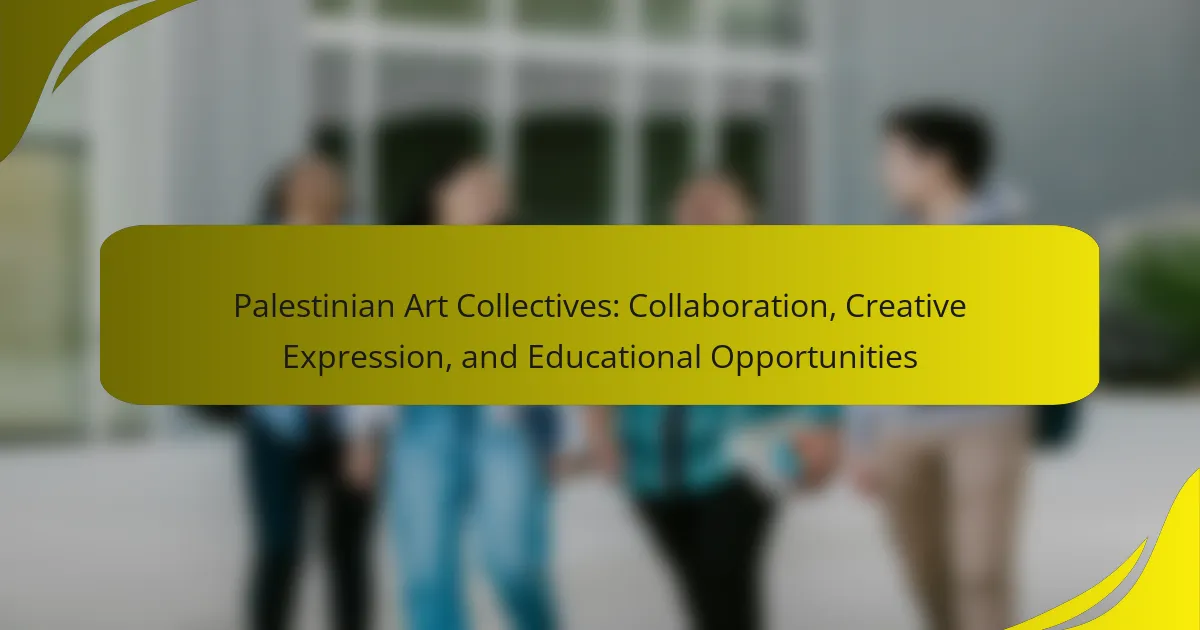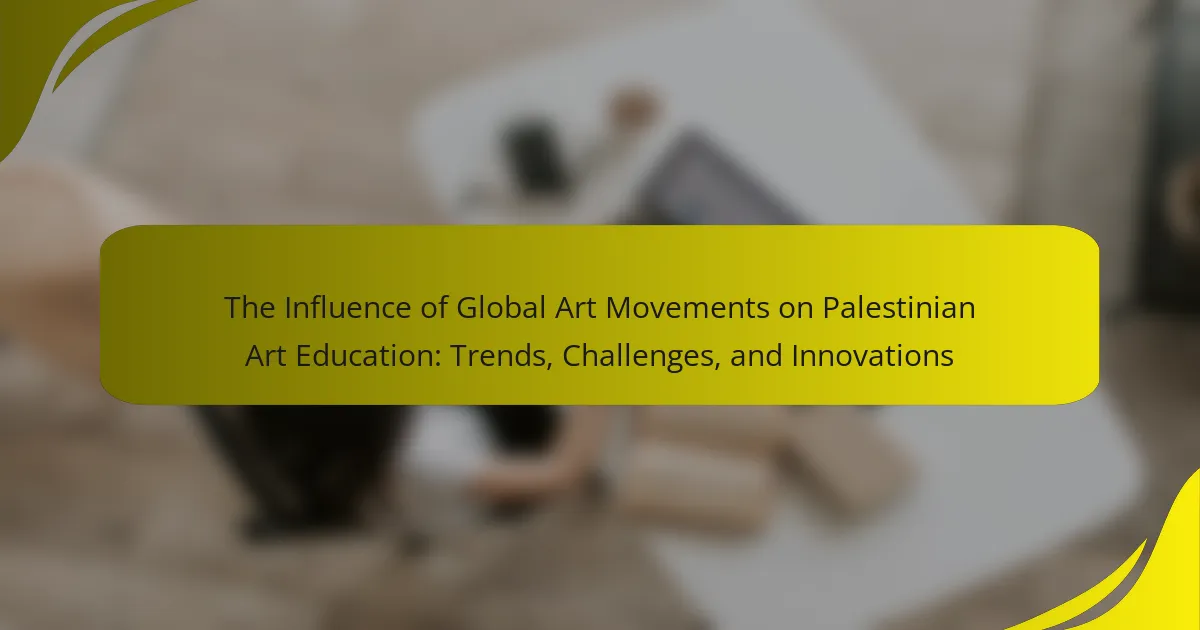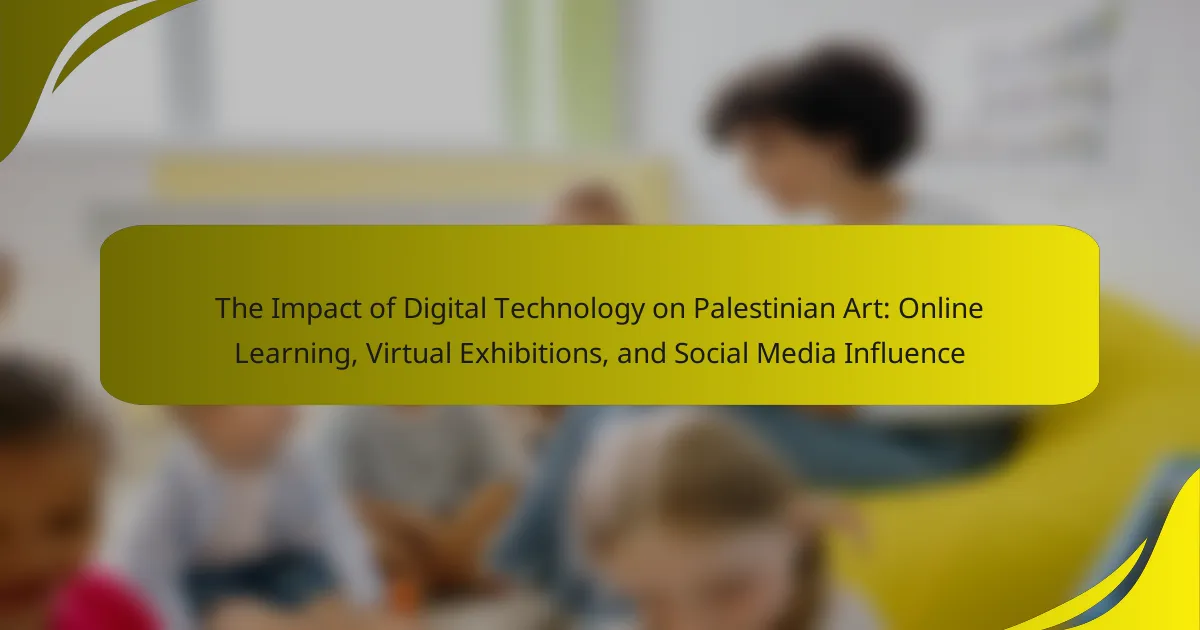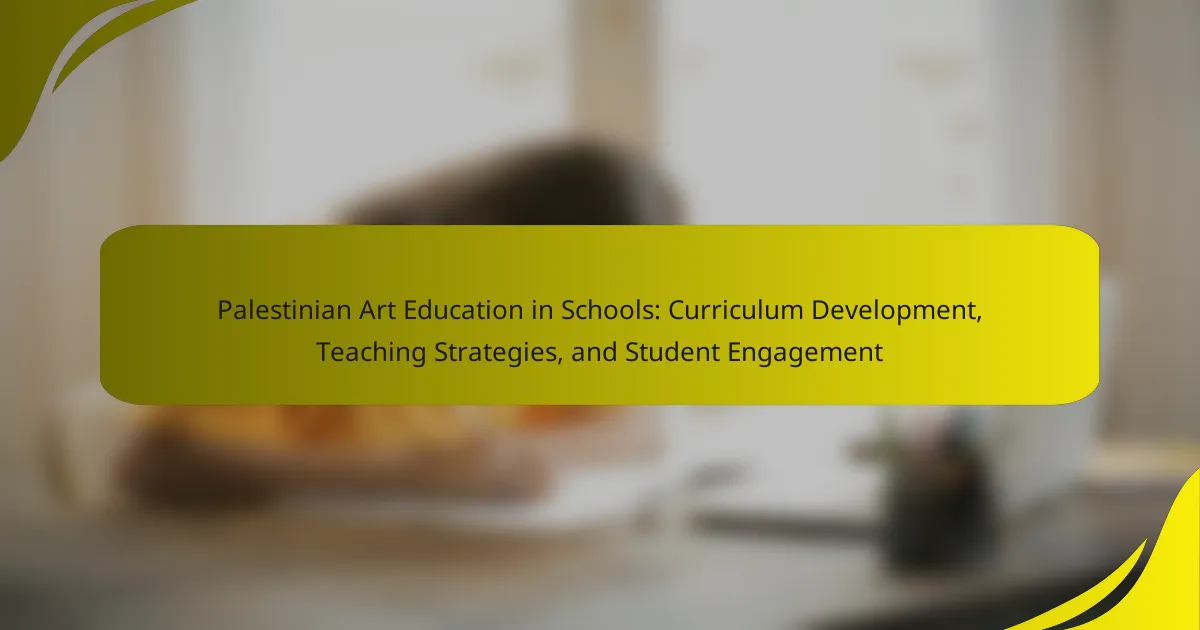Palestinian Art Education encompasses the teaching and learning of various artistic forms, including visual arts, music, and performance, within the Palestinian context. This educational framework aims to cultivate cultural identity and creativity among Palestinians, reflecting their socio-political realities and heritage. Art education is facilitated in schools, community centers, and informal workshops, playing a crucial role in preserving and promoting Palestinian culture. Institutions such as the International Academy of Art Palestine significantly contribute to this landscape, emphasizing the empowerment of individuals and communities through artistic engagement. The article explores the historical context, cultural significance, and teaching methods associated with Palestinian Art Education.
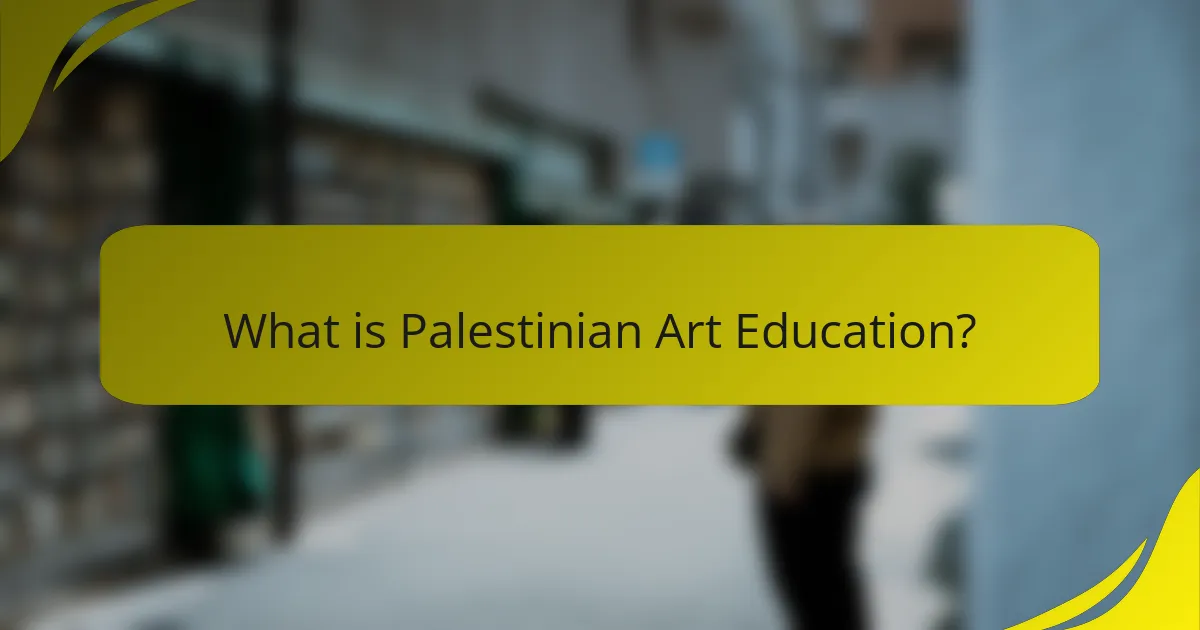
What is Palestinian Art Education?
Palestinian Art Education refers to the teaching and learning of art within the Palestinian context. It encompasses various forms of artistic expression, including visual arts, music, and performance. This education aims to foster cultural identity and creativity among Palestinians. It often reflects the socio-political realities and heritage of Palestinian society. Art education can occur in schools, community centers, and through informal workshops. It plays a crucial role in preserving and promoting Palestinian culture. Institutions like the International Academy of Art Palestine contribute to this educational landscape. Palestinian Art Education is vital for empowering individuals and communities through artistic engagement.
How has Palestinian Art Education evolved over time?
Palestinian Art Education has evolved significantly over the decades. Initially, art education was limited due to political and social constraints. In the early 20th century, art was primarily taught informally within communities. The establishment of formal institutions began in the 1970s, with the founding of art schools like the Bezalel Academy in Jerusalem.
The 1980s saw a surge in cultural expression, influenced by the Palestinian Liberation Movement. This period emphasized art as a tool for political expression and identity. In the 1990s, post-Oslo Accords, art education began incorporating contemporary practices and global art trends.
Today, Palestinian Art Education includes a diverse curriculum that merges traditional techniques with modern methodologies. Institutions now focus on fostering creativity and critical thinking. Collaborative projects with international art organizations have also expanded opportunities for Palestinian artists.
Overall, the evolution reflects a response to both local and global contexts, highlighting resilience and cultural identity through art.
What historical events have influenced Palestinian Art Education?
Palestinian Art Education has been influenced by several historical events. The Nakba in 1948 led to the displacement of Palestinians, impacting cultural expression. The establishment of the Palestinian Liberation Organization in the 1960s emphasized national identity through art. The First Intifada in the late 1980s fostered a rise in political art and community engagement. The Oslo Accords in the 1990s brought new opportunities for cultural exchange but also challenges due to ongoing conflict. The ongoing Israeli-Palestinian conflict continues to shape art education, reflecting resilience and resistance. These events have collectively shaped the curriculum and focus of art education in Palestine.
How have cultural shifts impacted the curriculum in Palestinian Art Education?
Cultural shifts have significantly impacted the curriculum in Palestinian Art Education. The curriculum has evolved to reflect the changing social and political landscape. Increased emphasis on identity and heritage has emerged in response to cultural shifts. This includes the integration of traditional Palestinian art forms into educational settings. Art education now often focuses on themes of resistance and resilience. The inclusion of contemporary Palestinian artists has also become prominent. This reflects a broader recognition of the role of art in social commentary. Additionally, the curriculum adapts to incorporate global art trends while maintaining local relevance. These changes collectively enhance the educational experience and cultural expression in Palestinian art.
What are the key components of Palestinian Art Education?
The key components of Palestinian Art Education include cultural identity, historical context, and artistic techniques. Cultural identity is emphasized to foster a sense of belonging among students. Historical context is crucial as it connects students to their heritage and struggles. Artistic techniques are taught to develop skills in various forms of expression. Additionally, community involvement plays a role in promoting art as a means of resistance and storytelling. The integration of traditional and contemporary practices enriches the curriculum. These components collectively aim to empower students and preserve Palestinian culture.
What types of artistic disciplines are taught in Palestinian Art Education?
Palestinian Art Education encompasses various artistic disciplines. These include visual arts, such as painting and sculpture. Additionally, it covers traditional crafts, including embroidery and pottery. Music education is also a significant component. Dance forms, particularly folk dance, are integrated into the curriculum. Theater arts are taught to promote performance skills. Photography and digital media are increasingly included in contemporary programs. Each discipline reflects the cultural heritage and social issues of Palestine. This diverse approach fosters creativity and cultural expression among students.
How do traditional and contemporary art forms coexist in the curriculum?
Traditional and contemporary art forms coexist in the curriculum by integrating both into a cohesive educational framework. This approach allows students to explore historical techniques alongside modern expressions. Traditional art forms, such as calligraphy and embroidery, are taught to preserve cultural heritage. Contemporary art practices, including digital media and installation art, are included to encourage innovation. Art educators often design projects that blend these styles, fostering creativity and critical thinking. For instance, students might create pieces that reflect traditional themes using contemporary methods. This coexistence enriches the learning experience and promotes cultural dialogue. Studies show that such integration enhances students’ appreciation for their cultural identity while engaging with global art trends.
What is the cultural significance of Palestinian Art Education?
Palestinian Art Education holds significant cultural importance as it serves as a means of preserving and expressing Palestinian identity. Through art, students explore their heritage and history, fostering a sense of belonging. The educational framework encourages critical thinking and creativity, essential for cultural resilience. Furthermore, it acts as a platform for political expression and social commentary, reflecting the realities of Palestinian life. Art education also promotes community engagement, connecting individuals through shared cultural experiences. Institutions like the International Academy of Art Palestine play a vital role in this educational landscape, providing resources and training. The impact of art education can be seen in various exhibitions and initiatives that highlight Palestinian narratives. Overall, Palestinian Art Education is a crucial element in sustaining cultural heritage and promoting social change.
How does Palestinian Art Education reflect national identity and heritage?
Palestinian Art Education reflects national identity and heritage by incorporating cultural themes and historical narratives. It emphasizes traditional Palestinian motifs and symbols in its curriculum. Students learn about the significance of their heritage through artistic expression. The education system often includes lessons on the impact of historical events on Palestinian culture. This approach fosters a sense of belonging among students. It also encourages the preservation of cultural practices. Research indicates that art serves as a medium for expressing resistance and resilience. Palestinian artists often draw inspiration from their collective history and experiences.
What role does art play in the expression of social and political issues in Palestine?
Art serves as a vital medium for expressing social and political issues in Palestine. It reflects the struggles and aspirations of the Palestinian people. Artists often use visual art, music, and performance to communicate resistance against occupation. Historical events, such as the Nakba, inspire many artworks. These pieces highlight themes of loss, identity, and resilience. Art also fosters community solidarity and cultural preservation. International exhibitions showcase Palestinian art, raising global awareness. For instance, the “Palestinian Art Movement” emphasizes the role of art in activism. Through art, Palestinians articulate their narratives and assert their rights.
How do teaching methods in Palestinian Art Education vary?
Teaching methods in Palestinian Art Education vary significantly based on cultural, historical, and social contexts. Educators often incorporate traditional techniques alongside modern practices. For instance, some methods emphasize community engagement and cultural identity. Others may focus on technical skills and contemporary art forms. The integration of local history and political themes is also common in teaching approaches. Additionally, resources and facilities can differ widely across regions, affecting the methods used. Overall, these variations reflect the diverse experiences and needs of Palestinian students in art education.
What pedagogical approaches are commonly used in Palestinian Art Education?
Palestinian Art Education commonly employs a mix of traditional and contemporary pedagogical approaches. These methods include experiential learning, which encourages students to engage directly with their environment and culture. Project-based learning is also prevalent, allowing students to create art that reflects their personal and communal narratives. Collaborative learning fosters teamwork and communication among students, enhancing their creative processes. Additionally, critical pedagogy is used to challenge societal norms and encourage students to express their identities through art. This multifaceted approach is essential for addressing the unique socio-political context of Palestine.
How do educators incorporate local culture into their teaching methods?
Educators incorporate local culture into their teaching methods by integrating culturally relevant materials and practices. They use local art forms, such as traditional crafts, to enhance learning experiences. Curriculum often includes local history and folklore to contextualize lessons. Educators also invite local artists to share their expertise with students. This approach fosters a sense of identity and belonging among learners. Research shows that culturally responsive teaching improves student engagement and academic success. Studies indicate that students perform better when their cultural backgrounds are reflected in the curriculum.
What challenges does Palestinian Art Education face today?
Palestinian Art Education faces significant challenges today. The ongoing political conflict limits resources and access to quality education. Restrictions on movement hinder students and teachers from participating in workshops and exhibitions. Additionally, the lack of funding affects art supplies and infrastructure. Cultural censorship further stifles creative expression in educational settings. There is also a shortage of trained art educators, which impacts the quality of instruction. These factors collectively hinder the development of a robust art education system in Palestine.
How do political and social factors affect access to art education in Palestine?
Political and social factors significantly restrict access to art education in Palestine. The ongoing conflict limits resources and funding for educational institutions. Restrictions on movement hinder students’ ability to attend art classes. Additionally, cultural norms may prioritize traditional subjects over the arts. The lack of governmental support further diminishes opportunities for artistic development. Reports indicate that many schools lack adequate art supplies and trained instructors. These challenges create barriers to creative expression and cultural education. The overall environment of instability affects students’ engagement with art education.
What resources are available to support Palestinian Art Education?
Resources available to support Palestinian Art Education include organizations, funding initiatives, and educational programs. Non-profit organizations, such as the Palestinian Art Court, provide platforms for artists and educators. They focus on promoting art and culture in Palestinian communities. Funding initiatives from international bodies support art projects and educational resources. Programs in universities and community centers offer workshops and training for aspiring artists. Additionally, online platforms facilitate access to art education materials. These resources aim to enhance artistic skills and cultural expression among Palestinians.
What best practices can enhance Palestinian Art Education?
Integrating community engagement is a best practice that can enhance Palestinian Art Education. This involves collaborating with local artists and cultural organizations. Such partnerships can provide students with real-world insights and mentorship opportunities. Incorporating traditional Palestinian art forms into the curriculum is also essential. This approach fosters cultural identity and appreciation among students.
Additionally, utilizing technology in art education can broaden access and engagement. Online platforms can facilitate virtual art exhibitions and workshops. Encouraging critical thinking through art critiques promotes deeper understanding and expression.
Finally, providing professional development for educators ensures they are equipped with contemporary teaching methods. Training programs can focus on culturally relevant pedagogy. Research indicates that these practices lead to improved student outcomes in art education.
How can community involvement improve art education programs?
Community involvement can significantly enhance art education programs by fostering collaboration and resource sharing. Engaging local artists and organizations provides students with mentorship and real-world experience. This connection enriches the curriculum with diverse perspectives and techniques. Community events can showcase student artwork, boosting visibility and appreciation for their efforts. Research shows that programs with strong community ties often have higher student engagement and retention rates. For instance, a study by the National Endowment for the Arts found that community-based art initiatives positively impact student creativity and academic performance. Therefore, integrating community involvement leads to a more vibrant and effective art education experience.
What strategies can educators use to foster creativity among students?
Educators can foster creativity among students by implementing project-based learning. This approach allows students to engage in hands-on projects that encourage exploration and innovation. Collaborative group work can enhance creativity by promoting diverse ideas and perspectives. Providing open-ended assignments encourages students to think critically and develop unique solutions. Incorporating art and visual expression into lessons stimulates creative thinking. Offering constructive feedback helps students refine their ideas and improve their work. Creating a supportive classroom environment allows students to take risks and express themselves freely. Lastly, integrating technology can provide new tools for creative expression and collaboration.
Palestinian Art Education encompasses the teaching and learning of various artistic expressions within the Palestinian context, focusing on cultural identity and creativity. The article explores its historical evolution, influenced by significant events such as the Nakba and the Oslo Accords, and highlights the integration of traditional and contemporary art forms in the curriculum. Key components include the emphasis on cultural identity, community involvement, and diverse artistic disciplines, while challenges such as political conflict and resource limitations are also addressed. The significance of art education in promoting social commentary and resilience within Palestinian society is underscored, along with strategies to enhance educational practices and foster creativity among students.
